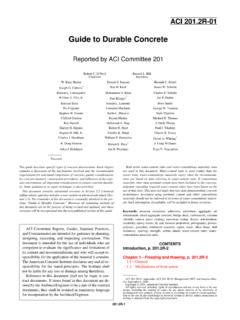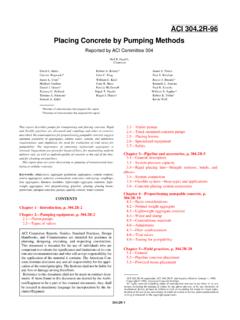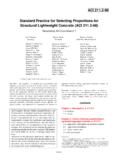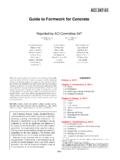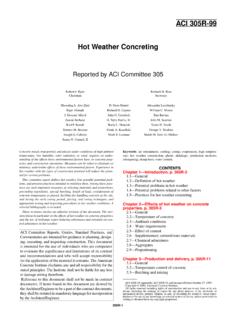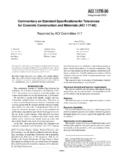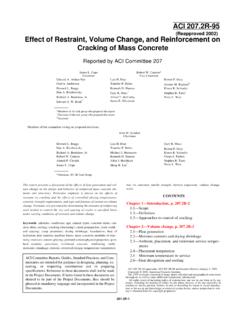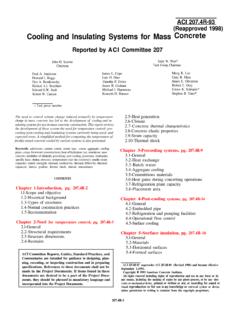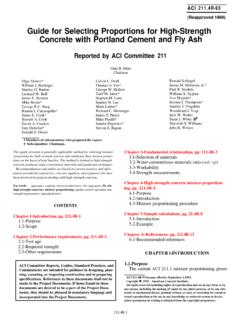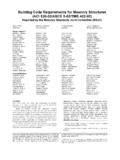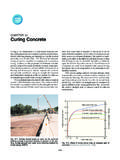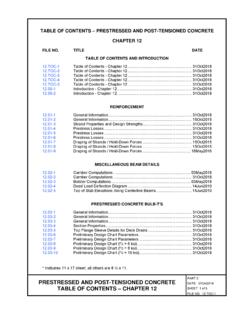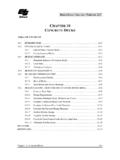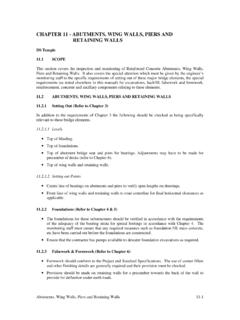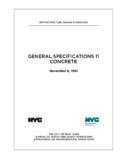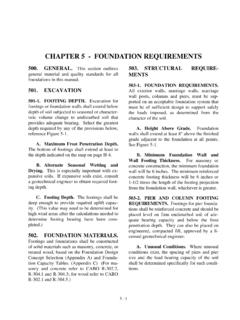Transcription of 224.1R-93 Causes, Evaluation and Repair of Cracks …
1 ACI , Evaluation and Repair of Reapproved 1998 Cracks in concrete StructuresReported by ACIC ommittee 224 Grant T. H&orsen*tChairmanRandall W. PostonSecretaryPeter BarlowtFlorian BarthtAlfred G. Bishara*Howard L BoggsMerle E. BrandeeDavid Darwin*Fouad H. FouadDavid W. FowlergPeter Gergely*Wii HansenM. Nadim HassounTony C. Iiu$Edward G. NawyHarry M. PalmbaumKeith A. PashinaAndrew Scanlon$Ernest K. SchraderWimal SuarisLewis H. TuthillZenon A. Zielinski* Contributing Authort Member of Task Group which prepared these revisions$ Principal Author0 Chairman of Task Group which prepared these revisionsNote: Associate members Masayatsu Ohtsu, Robert L. Yuan, and Consulting Member LeRoy Lutz contribute to the revision of this causes of Cracks in concrete structures are summarized The proce-dures used to evaluate cracking in concrete and the principal techniques forthe Repair of Cracks are presented The key methods of crack Repair arediscussed and guidance is provided for their proper applicationKeywords: autogenous healing; beams (supports); cement-aggregate reactions; concrete construction; concrete pavements; concrete slabs; concretes; consol-idation; corrosion; cracking (fracturing); drilling; drying shrinkage; epoxy resins; Evaluation ; failure; grouting, heat of hydration; mass concrete ; methacrylates; mixproportioning; plastics, polymers and resins; precast concrete ; prestressedconcrete; reinforced concrete ; repairs;resurfacing; sealing settlement (structural);shrinkage; specifications; structural design; tension; thermal expansion; , pg.
2 1- causes and control of cracking, pg. of plastic of hardened concreteACI Committee Reports, Guides, Standard Practices, andCommentaries are intended for guidance in designing, plan-ning, executing, or inspecting construction and in preparingspecifications. References to these documents shall not bemade in the Project Documents. If items found in thesedocuments are desired to be a part of the Project Docu-ments, they should be phrased in mandatory language andincorporated into the Project 2- Evaluation of cracking, pg. of location and extent of of Repair proceduresChapter 3-Methods of crack Repair , pg. and and and surface healingAC1 supersedes ACI and became effective September 1, d 1993, American concrete rights reserved including rights of reproduction and use in any form or byany means, including the making of copies by any photo process, or by any elec-tronic or mechanical devices, printed or written or oral, or recording for soundor visual reproduction or for use in any knowledge or retrieval system or device,unless permission in writing is obtained from the copyright ACI COMMITTEE REPORTC hapter 4-Summary, pg.
3 , pg. 5-References, pg. referencesPREFACEC racks in concrete have many causes . They may affectappearance only, or they may indicate significant struc-tural distress or a lack of durability. Cracks may repre-sent the total extent of the damage, or they may point toproblems of greater magnitude. Their significance de-pends on the type of structure, as well as the nature ofthe cracking. For example, Cracks that are acceptable forbuildings may not be acceptable in water-retaining proper Repair of Cracks depends on knowing thecauses and selecting the Repair procedures that take thesecauses into account; otherwise, the Repair may only betemporary. Successful long-term Repair procedures mustattack the causes of the Cracks as well as the aid the practitioner in pinpointing the best solutionto a cracking problem, this report discusses the Causes, Evaluation procedures, and methods of Repair of cracksin concrete .
4 Chapter 1 presents a summary of the causesof Cracks and is designed to provide background for theevaluation of Cracks . Chapter 2 describes Evaluation tech-niques and criteria. Chapter 3 describes the methods ofcrack Repair and includes a discussion of a number oftechniques that are available. Many situations will requirea combination of methods to fully correct the to the 1991 RevisionFollowing the initial publication of ACI in1985, the Committee processed two minor revisions. Onerevision, published as ACI simply updated theformat of recommended references. A second minor revi-sion contained minor technical revisions and editorialcorrections in the document, and added a new section toChapter 3, regarding the use of high-molecular-weightmethacrylates as 1990 a Committee 224 Task Croup reviewedthe document and recommended the revisions containedherein. Chapter 1 has been altered in only minor introduction to Chapter 2 has been revised exten-sively, and additional minor revisions have been made tothe rest of the Chapter.
5 In Chapter 3, the section onrouting and sealing has been rewritten to include flexiblesealing and overbanding of Cracks , and it is updated toreflect current materials and construction practices. Sec-tion on epoxy injection has been revised to be some-what more general and reflect current practice. The for-mer section on high-molecular-weight methacrylates hasbeen moved to Section and retitled Gravity Filling. This recognizes the point that high-molecular-weightmethacrylate is a material, and not a method. Refer-ences are presented in Chapter 5; citations throughoutthe text have been revised to employ the author/dateformat. Several new references have been revision of the report is ongoing. Commit-tee 224 invites comment from the readers and users ofthis report on new developments, or alternate viewpointson the causes , Evaluation , and Repair of Cracks in Con-crete 1- causes AND CONTROLOF chapter presents a brief summary of the causes ofcracks and means for their control.
6 Cracks are categor-ized as occurring either in plastic concrete or hardenedconcrete (Kelly 1981; Price 1982). In addition to the in-formation provided here, further details are presented inACI 224R and articles by Carlson et al. (1979), Kelly(1981), Price (1982),,and Abdun-Nur (1983). Additionalreferences are cited throughout the of plastic Plastic shrinkage cracking-"Plastic shrinkagecracking (Fig. ) subjected to a veryrapid loss of moisture caused by a combination of factorswhich include air and concrete temperatures, relativehumidity, and wind velocity at the surface of the con-crete. These factors can combine to cause high rates ofsurface evaporation in either hot or cold weather. When moisture evaporates from the surface of freshlyplaced concrete faster than it is replaced by bleed water,the surface concrete shrinks. Due to the restraint pro-vided by the concrete below the drying surface layer, ten-sile stresses develop in the weak, stiffening plastic con-crete, resulting in shallow Cracks of varying depth which----Fig.
7 Plastic shrinkage cracking (Price 1982) causes , Evaluation AND Repair OF formed due to obstructed settlement (Price1982)80604020 Bar Size~~\Slump0I III Cover (19mm) 1 (25mm) 1 1/2" (38mm) 2 (51mm)Bar Size: (13mm) (16mm) (19mm)Slump: 2 (51mm) 3 (76mm) 4 (102mm) Fig. cracking as a function of bar size,slump and cover (Dakhil et al. 1975)may form a random, polygonal pattern, or may appear asessentially parallel to one another. These Cracks are oftenfairly wide at the surface. They range from a few inchesto many feet in length and are spaced from a few inchesto as much as 10 ft (3 m) apart. Plastic shrinkage cracksbegin as shallow Cracks but can become full-depth plastic shrinkage cracking is due to a differentialvolume change in the plastic concrete , successful controlmeasures require a reduction in the relative volumechange between the surface and other portions of can be taken to prevent a rapid moisture lossdue to hot weather and dry winds (ACI 224R, , ACI 305R).
8 These measures include the use offog nozzles to saturate the air above the surface and theuse of plastic sheeting to cover the surface betweenfinishing operations. Windbreaks to reduce the windvelocity and sunshades to reduce the surface temperatureare also helpful, and it is good practice to schedule flatwork after the windbreaks have been Settlement cracking - After initial placement,vibration, and finishing, concrete has a tendency to con-tinue to consolidate. During this period, the plastic con-crete may be locally restrained by reinforcing steel, aprior concrete placement, or formwork. This local re-straint may result in voids and/or Cracks adjacent to therestraining element (Fig. ). When associated with rein-forcing steel, settlement cracking increases with in-creasing bar size, increasing slump, and decreasing cover(Dakhil et al. 1975). This is shown in Fig. for alimited range of these variables.
9 The degree of settlementcracking may be intensified by insufficient vibration orby the use of leaking or highly flexible design (ACI 347R) and vibration (and revibra-tion), provision of a time interval between the placementof concrete in columns or deep beams and the placementof concrete in slabs and beams (ACI ), the use ofthe lowest possible slump, and an increase in concretecover will reduce settlement of hardened Drying shrinkage-A common cause of crackingin concrete is restrained drying shrinkage. Dryingshrinking is caused by the loss of moisture from thecement paste constituent, which can shrink by as much as1 percent. Fortunately, aggregate provides internal re-straint that reduces the magnitude of this volume changeto about percent. On wetting, concrete tends moisture-induced volume changes are a charac-teristic of concrete . If the shrinkage of concrete couldtake place without restraint, the concrete would notcrack.
10 It is the combination of shrinkage and restraint(usually provided by another part of the structure or bythe subgrade) that causes tensile stresses to the tensile strength of concrete is exceeded, it willcrack. Cracks may propagate at much lower stresses thanare required to cause crack massive concrete elements, tensile stresses arecaused by differential shrinkage between the surface andthe interior concrete . The larger shrinkage at the surfacecauses Cracks to develop that may, with time, penetratedeeper into the magnitude of the tensile stresses induced by vol-ume change is influenced by a combination of factors, in-cluding the amount of shrinkage, the degree of restraint,the modulus of elasticity, and the amount of creep. Theamount of drying shrinkage is influenced mainly by theamount and type of aggregate and the water content ofthe mix. The greater the amount of aggregate, thesmaller the amount of shrinkage (Pickett 1956).
